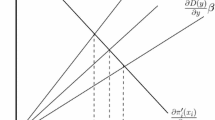Abstract
Pollution is an inevitable by-product of production and is only gradually dissolved by the environment. It can be reduced by producing less and by cleaning up the environment, but neither occur when they are left to the market. Cleaning activities and the optimal emission charges increase with the stock of pollutants. When one allows for pollution of the environment in the classical Ramsey problem, the capital stock is less than in the market outcome and a fortiori less than under the golden rule. The analysis distinguishes between stock and flow externalities arising from pollution. An increase in impatience can lead to more capital accumulation, even though this leaves less room for current consumption.
Similar content being viewed by others
References
Becker, Robert A. (1982), ‘Intergenerational Equity: The Capital-Environment Trade-Off’, Journal of Environmental Economics and Management 9, 165–185.
Blanchard, Olivier J. and StanleyFischer (1989), Lectures on Macroeconomics, MIT Press, Cambridge.
Brock, William A. (1977), ‘A Polluted Golden Age’, in V. Smith (ed.), Economics of Natural and Environmental Resources, Gordon and Breach.
Dasgupta, Partha (1982), The Control of Resources, Basil Blackwell, Oxford.
Forster, B. A. (1973), ‘Optimal Capital Accumulation in a Polluted Environment’, Southern Economic Journal 39, 544–547.
Gruver, G. (1976), ‘Optimal Investment and Pollution Control in a Neoclassical Growth Context’, Journal of Environmental Economics and Management 5, 165–177.
Keeler, Emmett, MichaelSpence, and RichardZeckhauser (1971), ‘The Optimal Control of Pollution’, Journal of Economic Theory 4, 19–34.
Mäler, Karl (1974), Environmental Economics: A Theoretical Inquiry, John Hopkins, University Press, Baltimore.
Musu, Ignazio (1989), ‘Optimal Accumulation and Control of Environmental Quality’, Nota di Lavoro n. 8903, University of Venice.
Phelps, Edmund S. (1966), Golden Rules of Economic Growth. Studies of Efficient and Optimal Investment, W. W. Norton, New York.
Ramsey, Frank P. (1928), ‘A Mathematical Theory of Saving’, The Economic Journal 38, 534–559.
Siebert, Horst (1987), Economics of the Environment, Springer-Verlag.
Tahvonen, Olli (1990), On the Dynamics of Renewable Resource Harvesting and Pollution Control, mimeo, Helsinki School of Economics.
Tahvonen, Olli and Jari Kuuluvainen (1990), Renewable Resources, Economic Growth and Pollution, mimeo, Helsinki School of Economics.
Author information
Authors and Affiliations
Rights and permissions
About this article
Cite this article
Van Der Ploeg, F., Withagen, C. Pollution control and the Ramsey problem. Environmental and Resource Economics 1, 215–236 (1991). https://doi.org/10.1007/BF00310019
Issue Date:
DOI: https://doi.org/10.1007/BF00310019




